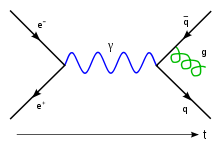- Vacuum expectation value
-
Quantum field theory 
History of... BackgroundSymmetriesIncomplete theoriesScientistsJamal Nazrul Islam • Adler • Bethe • Bogoliubov • Callan • Candlin • Coleman • DeWitt • Dirac • Dyson • Fermi • Feynman • Fierz • Fröhlich • Gell-Mann • Goldstone • Gross • 't Hooft • Jackiw • Klein • Landau • Lee • Lehmann • Majorana • Nambu • Parisi • Polyakov • Salam • Schwinger • Skyrme • Stueckelberg • Symanzik • Tomonaga • Veltman • Weinberg • Weisskopf • Wilson • Witten • Yang • Yukawa • Hoodbhoy • Zimmermann • Zinn-JustinIn quantum field theory the vacuum expectation value (also called condensate or simply VEV) of an operator is its average, expected value in the vacuum. The vacuum expectation value of an operator O is usually denoted by
 . One of the best known examples of an observable physical effect that results from the vacuum expectation value of an operator is the Casimir effect.
. One of the best known examples of an observable physical effect that results from the vacuum expectation value of an operator is the Casimir effect.This concept is important for working with correlation functions in quantum field theory. It is also important in spontaneous symmetry breaking. Examples are:
- The Higgs field has a vacuum expectation value of 246 GeV. This nonzero value allows the Higgs mechanism to work.
- The chiral condensate in Quantum chromodynamics gives a large effective mass to quarks, and distinguishes between phases of quark matter.
- The gluon condensate in Quantum chromodynamics may be partly responsible for masses of hadrons.
The observed Lorentz invariance of space-time allows only the formation of condensates which are Lorentz scalars and have vanishing charge. Thus fermion condensates must be of the form
 , where ψ is the fermion field. Similarly a tensor field, Gμν, can only have a scalar expectation value such as
, where ψ is the fermion field. Similarly a tensor field, Gμν, can only have a scalar expectation value such as  .
.In some vacua of string theory, however, non-scalar condensates are found. If these describe our universe, then Lorentz symmetry violation may be observable.
See also
Categories:- Quantum field theory
- Standard Model
- Quantum physics stubs
Wikimedia Foundation. 2010.
